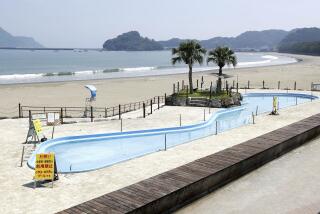Wall of Water or Soft Kiss, Tsunamis Mystify
TOKYO — Shaken awake by a major earthquake, Toshimi Adachi instinctively hustled her children out of bed to race for high ground.
They didn’t make it.
Within minutes, they were swallowed up by a wall of water 48 feet high, a tsunami that washed most of her fishing village in northern Japan out to sea.
Though armed with possibly the best monitoring system in the world, officials in tsunami-prone Japan admit that the waves can be as notoriously hard to predict--and warn against--as the earthquakes that cause them.
Japan maintains six regional tsunami monitoring centers where offshore seismological activity is watched and analyzed around the clock. If a tsunami is deemed likely after a quake near shore, warnings can be issued in a matter of minutes. Each year, many are.
“We probably have the fastest warning system in the world,” said Makoto Saito, an administrator who oversees the system for Japan’s Meteorological Agency.
But even minutes can be too long.
Adachi, for example, had no warning about the earthquake itself before the tsunami destroyed her village on Okushiri Island in northern Japan. About 234 people died in the waves and fires caused by the 1993 quake.
“We didn’t even have time to change our clothes,” Adachi said by telephone from her home. “All of a sudden we were submerged. All I could hear was water rushing in around us.”
After floating in the darkness for two hours, Adachi and her children were rescued by a passing trawler.
Japan, an arc along the Pacific Ocean’s “ring of fire,” sits precariously atop three tectonic plates, the slabs of land that make up the earth’s crust.
Because of its volatile location, Japan has a long history of tsunami-caused disasters. This summer, Japan marked the centennial of the worst one in modern times--a tsunami that killed more than 22,000 people.
Experience has taught many along Japan’s shores to head for the hills after an earthquake strikes.
Predicting the force of a tsunami, however, remains an elusive goal for scientists.
Along with the unpredictability of the earthquakes that cause them, telling whether a tsunami will be a devastating giant or a relatively small wave is difficult because of the close relationship between its run-up size--how big it is when it hits land--and the local geography.
The contours of the coastline can funnel the tsunami into a major killer or let it dissipate harmlessly.
Japanese emergency officials issue tsunami warnings based largely on the strength and location of the earthquake that caused it.
A warning is issued if the tsunami is expected to be 10 inches or more, and an alert if the tsunami is expected to be bigger than three feet.
Though fast and generally efficient, the warnings can at times be confusing.
The most recent full-scale alert was issued in October 1995 after a strong quake hit near some islands in southern Japan. Hundreds of thousands of people were warned to get away from the shores, and maps of the southern Japan coastline in flashing red were broadcast nationwide.
After three hours, the alert was lifted. Newspapers the next day noted that the biggest waves to hit most areas were an almost imperceptible 4 1/2 inches high.
Katsuyuki Abe, a leading tsunami researcher with Tokyo University’s Seismological Research Institute, said the October alert wasn’t totally off-base--6-foot waves were registered at a small island near the quake’s epicenter.
“But the warnings are too rough, the area too wide,” he said. “There is the fear that they will create a boy-who-cried-wolf-effect, that people will stop listening.”
To help ease that problem, Abe has devised a tsunami magnitude scale to quantify the size of a tsunami much the way magnitude scales are used for earthquakes.
Combined with detailed information on past tsunami and local seabed conditions, he says, the scale can be used to help predict what areas are in the most danger and help officials limit their warnings to more specific locations, instead of whole coastlines.
Actually putting Abe’s approach into practice, however, would take upgraded computers and better shoreline data than are now available, according to the meteorological agency’s Saito.
“Right now,” he said, “we just don’t have the infrastructure.”
More to Read
Sign up for Essential California
The most important California stories and recommendations in your inbox every morning.
You may occasionally receive promotional content from the Los Angeles Times.










